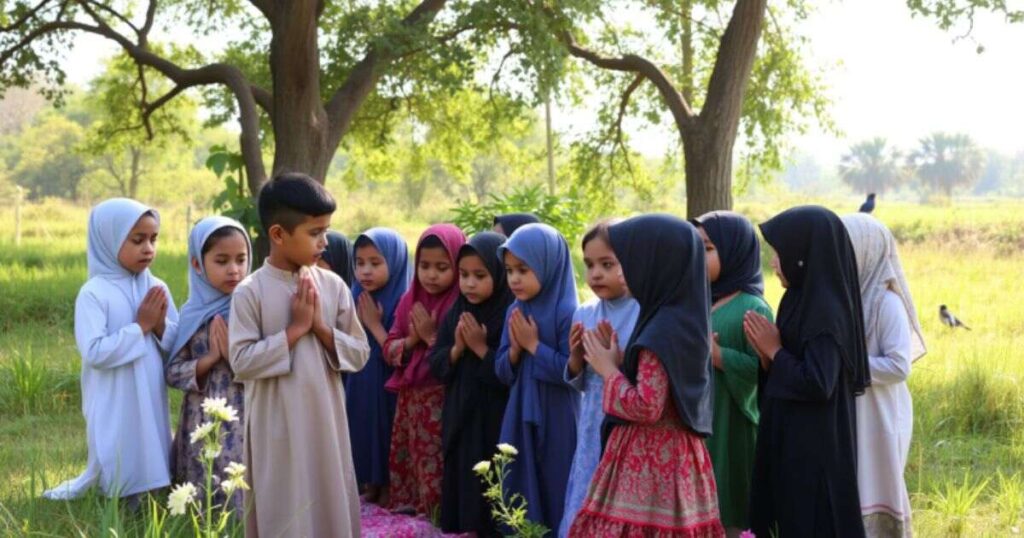Raising children in accordance with Islamic teachings is a sacred responsibility. Among the many essential practices is Salah prayer, the foundation of a Muslim’s connection with Allah. Instilling this habit early ensures it becomes second nature, nurturing faith and discipline. But how do we introduce children prayer in Islam with wisdom, love, and consistency?
Understanding the Importance of children prayer in Islam
This guide provides parents with practical steps and spiritual insights to make prayer an integral part of a child’s life.
1. Begin with the Love of Allah
Teaching begins with the heart. Help your child build a strong emotional bond with Allah by emphasizing His mercy and kindness. Explain how prayer is a way to speak with the Creator who loves them deeply. Use bedtime stories from the Quran and Hadith that highlight Allah’s care for His creation. In this way, children prayer in Islam becomes a natural response to divine love rather than a chore. Show them that Allah listens, understands, and appreciates their prayers.Start by nurturing your child’s emotional and spiritual connection with the Creator. Use names like Ar Rahman “The Most Merciful” and Ar Razzaq “The Provider” to help them understand who Allah is. Reassure them that Allah listens to everyone, including little ones, and that prayer is a special invitation to speak directly with Him. Incorporate bedtime reminders like “Allah loves when we talk to Him.”
2. Set the Example Through Daily Practice
Children learn more by watching than listening. Make sure you never miss your own prayers and let your children observe you in Salah. When they see your dedication, they understand the importance of prayer. Share your feelings about how prayer gives you peace and direction. By modeling the behavior, you silently encourage children prayer in Islam without forcing it. Actions truly speak louder than words in nurturing faith.Children observe and imitate. Make sure your daily prayer is done with sincerity and peace. Don’t just perform it live it. Let them see you preparing for prayer, performing ablution with calmness, and praying with devotion. Speak positively about how it gives you peace. They will internalize your attitude and energy. If you’re excited and respectful, they will mirror that behavior. Include them by saying, “Would you like to pray with me?” instead of forcing them. Your lifestyle becomes their first textbook.
3. Teach the Purpose of Prayer
Children are naturally curious. Instead of saying “because Allah says so,” explain why Muslims pray. Let them know prayer is our way to stay connected with Allah, seek guidance, and show gratitude. When children understand the purpose, their participation becomes more sincere. Clarify that prayer helps them grow spiritually and emotionally. This deeper understanding strengthens their connection with children prayer in Islam. Rather than only focusing on how to perform acts of worship, explain the why. Share that it’s not about ritual alone but about connection, gratitude, and reliance. Help them realize that we pray to thank Allah, to ask for His help, and to stay close to Him in our hearts. You could say, “When you feel scared or happy or want something special, that’s when you turn to Allah.” Such explanations make acts of worship heartfelt, not mechanical.
4. Make It a Joyful Experience
Instead of making prayer feel like an obligation, make it something to look forward to. Allow your child to choose their prayer mat or wear special clothes for Salah. Sing short nasheeds about prayer or tell uplifting stories afterward. Celebrate their progress in memorizing short surahs. The joy surrounding prayer encourages consistent practice and deepens their appreciation for children prayer in Islam.Children respond to excitement and joy. Let prayer time feel like a positive break from their daily activities. Use colorful prayer mats, let them wear their favorite clothes, or introduce a small ‘prayer celebration’ when they learn a new surah. You can even let them design their own prayer chart or sticker tracker. Positive associations will build long-term enthusiasm. Replace correction with praise when they try, even if it’s imperfect. Make the experience special, and they’ll look forward to it.
5. Start Early with Gentle Encouragement
The Prophet Muhammad advised parents to encourage prayer at age seven. Start with short reminders, not strict rules. Let your child join you during prayer even if they don’t know the full actions. Praise their efforts and gently correct mistakes. With time and repetition, children prayer in Islam becomes a cherished habit.Begin nurturing the habit from toddler years through imitation, then introduce structure by age seven. Use the early years to simply invite them to join you. If they wander off mid prayer, don’t scold. The Prophet ﷺ allowed children to play on his back during sujood. Reflect that same compassion. As they grow older, begin gentle encouragement with consistency but not pressure. Starting early ensures the habit grows with them and is not viewed as something new or burdensome later.
6. Create a Prayer Routine
Children thrive on routine. Schedule prayer times into their daily rhythm like meals and bedtime. Use prayer clocks or apps to remind them when it’s time to pray. Structure builds discipline and reduces the chances of missing Salah. The more integrated it becomes in their schedule, the more natural children prayer in Islam will feel. Link worship with existing habits like waking up, meals, or bedtime routines. For example, after brushing their teeth at night, remind them, “Let’s do our evening prayer now.” Predictable structure reinforces habit-forming. Children feel safe when routines are predictable. Using alarms or visual schedules can also assist. Repetition will make worship a stable part of their day, just like school or brushing their teeth
7. Teach Wudu with Fun and Patience
Wudu is the gateway to Salah. Turn the process of ablution into a bonding moment. Teach each step with its meaning and significance. Use rhymes or visual aids to make it easier for them to remember. Teaching wudu with patience helps children approach children prayer in Islam with cleanliness and awareness. Explain that cleanliness is not only physical but spiritual. Describe how each part washed during ablution is spiritually purified our hands from bad deeds, our tongues from unkind words, our feet from going to wrong places. Create fun activities where they color each step or perform it with siblings. Reinforce that preparation for prayer begins with inner and outer cleanliness. This will help them understand the sacredness of what they’re about to do.
8. Use Stories from the Lives of the Prophets
Children love stories, and Islamic history is full of inspiration. Share how Prophet Ibrahim (AS) and Prophet Muhammad prayed with devotion. Explain how even the youngest companions of the Prophet took prayer seriously. These role models help children visualize what prayer looked like in earlier times and motivate them to continue the tradition of children prayer in Islam. Prophet Muhammad ﷺ was the ultimate teacher. Share with your child how he treated children with kindness and involved them in acts of worship. Tell stories of companions like Abdullah ibn Abbas and Anas ibn Malik who began practicing the faith from a young age. Hearing that children participated in Islamic rituals and were praised by the Prophet ﷺ builds motivation. Stories inspire imagination, and children connect deeply through them.
9. Encourage Questions and Curiosity
Let your children ask questions about prayer without fear. Whether it’s about movements, words, or why we pray five times a day, respond thoughtfully. Engaging in conversation reinforces learning and helps children feel valued. A curious mind leads to a sincere heart, especially when teaching children prayer in Islam. Welcome your child’s questions about God, prayer, or why certain actions are done. Respond with openness and without judgment. For instance, if they ask why we bow or prostrate, explain that it symbolizes submission to our Creator. Use everyday metaphors they understand. Answering their questions strengthens their trust in you as a guide and helps them find meaning in worship.
10. Reward Consistency, Not Perfection
Don’t wait for perfect performance. Acknowledge their efforts even when they make mistakes. Rewarding consistency boosts confidence and commitment. Use kind words, hugs, or small treats to mark milestones. This positive reinforcement supports lasting habits for children prayer in Islam. Recognize every step they take. Whether it’s remembering a part of the prayer, learning a new surah, or even showing more focus, celebrate it. Praise them genuinely. You can have a ‘Faith Journal’ to document their progress or keep a reward system for spiritual achievements. Milestones could also be family celebrations like “Today, you led your first dua!” This positive reinforcement motivates further involvement.

11. Introduce One Salah at a Time
Instead of overwhelming them with all five prayers, start with one preferably Maghrib or Fajr. As they grow comfortable, gradually introduce the others. This gradual approach builds stamina and spiritual focus. It helps children appreciate the beauty and discipline of children prayer in Islam. Instead of expecting them to jump into all five prayers, introduce one prayer at a time. Start with Maghrib due to its convenient timing. Once they’re consistent, add another gradually. This keeps the process manageable and builds confidence. Overwhelming a child with too much too soon can lead to avoidance. Gradual learning helps cement each step with understanding.
12. Pray Together as a Family
There is great spiritual unity in congregational prayer. Make it a point to pray as a family, especially on weekends or holidays. This strengthens family bonds and creates spiritual alignment. It also reinforces the value of children prayer in Islam in a communal setting. Invite your children to pray with you as a group, even if it’s just two people. Congregational prayer brings unity and provides structure. If you have multiple children, let them stand side by side. Let them hear the recitations aloud. They’ll notice the rhythm, movements, and sense of purpose. This experience builds community spirit and boosts spiritual development in a home environment.
13. Let Children Lead Occasionally
Allow your child to lead a short prayer or recite a surah during Salah. This builds their confidence and strengthens memory. Leading makes them feel responsible and respected in matters of Deen. Involving them actively fosters commitment to children prayer in Islam. Children enjoy feeling responsible. Let them choose which surah to recite or lead a short dua. Even if they don’t lead the full prayer, asking them to make a supplication aloud after prayer teaches them that their voice matters in front of Allah. Leadership strengthens their confidence and emotional investment in faith practices.
14. Explain the Meaning of Surahs
Children often memorize without understanding. Take time to explain the meaning of Al Fatihah and short surahs. Use simple language and visual stories to explain verses. When children connect with the meaning, children prayer in Islam becomes heartfelt, not mechanical. Don’t let their memorization be robotic. Explain the meanings of key phrases like Allahu Akbar, Alhamdulillah, or Subhana Rabbiyal Azeem. Use child friendly language. When they say Al Fatihah, let them understand they’re praising Allah and asking for guidance. Understanding creates emotional and spiritual engagement. Even learning one line deeply is more meaningful than memorizing many without comprehension.
15. Create a Special Prayer Corner
Designate a calm, beautiful space at home for Salah. Decorate it with Islamic art, prayer beads, and books. Having a sacred space reinforces the importance of prayer. This atmosphere enhances focus and excitement for children prayer in Islam. Designate a small prayer area in your home with prayer mats, a Quran, and perhaps some Islamic art. This ‘prayer corner’ becomes their personal place for worship. It sends a message that faith is not confined to the mosque but is part of everyday life. Having their own space also promotes a sense of belonging and responsibility toward it.
16. Be Patient and Avoid Harshness
Every child progresses differently. Don’t compare or criticize them for forgetting or missing prayers. Harshness can push them away from faith. Gentle correction and continuous encouragement work best when teaching children prayer in Islam. Children will forget, fidget, or resist and that’s okay. Avoid frustration or anger. Remind yourself of the Prophet’s ﷺ kindness toward children. Even in worship, he shortened his prayer when hearing a baby cry. Use that example in your home. Continue inviting and encouraging them gently. Trust that your patience will bear fruit with time and supplication.
17. Use Visual Aids and Educational Tools
Islamic posters, flashcards, and mobile apps can help children learn prayer steps easily. Visual learners especially benefit from these tools. When used correctly, they enhance memory and motivation to embrace children prayer in Islam. Many children are visual learners. Use illustrated posters of prayer steps, Islamic videos, or mobile applications that teach through animation. These tools make learning easier and more fun. While tech should be balanced, it can serve as a valuable support system to engage younger minds in learning their duties in an appealing way.
18. Include Duas in Their Daily Life
Start and end the day with simple duas. Encourage saying Bismillah before meals and Alhamdulillah after. Integrating daily supplications builds a spiritual routine. These moments remind children that prayer isn’t only during Salah but a constant connection with Allah, deepening their understanding of children prayer in Islam. Before diving into full length prayers, begin with short duas. Start with waking up, before eating, or when leaving the house. These small prayers connect them to Allah during the day and build spiritual mindfulness. Slowly, these become automatic and introduce them to a rhythm of remembrance that complements their larger acts of worship.
19. Praise Their Spiritual Growth
Acknowledge when your child shows understanding, focus, or emotional connection during Salah. Say things like “You looked very focused today,” or “Your recitation was beautiful.” This boosts self-esteem and encourages consistency. Compliments nourish the soul and support long-term success in children prayer in Islam. Sometimes the heart grows even before the actions show. If your child expresses joy in worship, shows remorse for missing a prayer, or reminds others to pray, praise those signs of maturity. Mention their growing relationship with Allah in your conversations. Highlight spiritual wins, not just physical ones. This helps deepen their understanding of faith development.
You may also like:PrayerTechy

20. Seek Allah’s Help Together
Finally, remind your children that prayer is not just an action it’s a plea for guidance. Pray together and ask Allah to keep your hearts firm in faith. Make dua for their spiritual journey. Involving Allah in the process teaches children the true essence of children prayer in Islam complete reliance on the Creator. Ultimately, guidance comes from Allah. As a parent, your responsibility is effort but the result is from Him. Frequently raise your hands and pray for your child’s steadfastness, love for worship, and sincerity. Let them hear you making dua for them. It reinforces your concern and strengthens their spiritual identity. The Prophet ﷺ often prayed for his companions; you should too for your child.
You may also like:PrayerTechy
Frequently Asked Questions
1. At what age should I start teaching my child Salah?
You can start introducing the concept of prayer around age 4 or 5, but formal encouragement begins at age 7, as per Islamic teachings.
2. How do I encourage prayer without forcing my child?
Be a role model, use gentle encouragement, and create a joyful environment around prayer.
3. What if my child forgets or refuses to pray?
Be patient. Avoid scolding. Instead, kindly remind them and inspire with stories and positive reinforcement.
4. Can I use rewards to motivate my child to pray?
Yes, small incentives can be helpful if used wisely. Focus on spiritual benefits as well.
5. How do I make prayer fun for my children?
Use colorful prayer mats, nasheeds, visual aids, and let them lead occasionally.
6. Is it okay if my child makes mistakes during prayer?
Absolutely. Gently correct them. Mistakes are part of learning.
You may also like:PrayerTechy
7. Should I teach the meaning of the Surahs to my child?
Yes, understanding the meaning deepens their spiritual connection.
8. What if I am not perfect in my own prayer?
Children value effort. Your sincerity and consistency will guide them more than perfection.
9. How can I teach my child Wudu effectively?
Demonstrate it with fun, use rhymes, and let them copy you.
10. Are Islamic apps useful for teaching prayer?
Yes, age appropriate apps can visually and interactively support learning.
You may also like:PrayerTechy

Conclusion
Teaching children prayer in Islam is a sacred journey filled with love, patience, and divine reward. By creating a nurturing environment and leading through example, parents can guide their children toward a lifelong relationship with Allah. Remember, the goal is to instill love for prayer, not just its performance. With consistency, understanding, and dua, the seeds of faith you plant today will blossom into righteous habits tomorrow. May Allah bless every parent striving to raise children who love and cherish Salah.

You may also like:PrayerTechy

Hi I’m Hamza Basharat SEO content writer with 4 years of experience and founder of PrayerTechy.com. I combine faith and strategy to help people discover how to pray with purpose, using well optimized, impactful content rooted in scripture and spiritual growth.



1 thought on “How to Teach Children to Pray in Islam A Parent’s Guide”